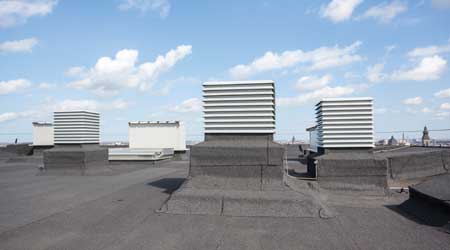 Replacing rooftop equipment, such as HVAC units, must be done carefully under close supervision to prevent damaging the newly installed roof.
Replacing rooftop equipment, such as HVAC units, must be done carefully under close supervision to prevent damaging the newly installed roof.Assessments Critical for Successful Roof Replacements
Close attention to roof specification, installation and maintenance can ensure long performance life for a valuable facility component
The roof of a commercial or institutional facility can degrade from a variety of causes, from normal aging of the material, wind, rain, and ice and snow loads to building movement or settling, improper design, and natural disasters. Roof-condition assessments help maintenance and engineering managers evaluate roof material resistance to aging and compare the current condition to history records.
Assessments also can help managers develop information to be used in planning to ensure sustainability, optimizing life-cycle cost, and make repair-or-replace decisions.
Before starting the assessment, managers should review repair history, the backlog of roof repairs, and thermal images and photos of potential problem areas to highlight improvements needed by comparison. The parameters of the assessment can encompass roofing materials, accessories, and installation methods.
Roofing materials that inspectors should check carefully include the deck, insulation and weatherproofing membrane, while the key accessories include flashing, scuppers, collectors, drains, parapets, and sealants around each penetration through the membrane.
The assessment also should check key installation methods and locations — the way the membrane, flashing, scuppers, downspouts and penetrations were designed, constructed, and sealed during construction or repair.
These are the main steps an inspector should take to ensure a successful assessment:
• Visually inspect the roof for overhanging tree limbs or loose objects that can plug up scuppers or penetrate the membrane.
• Check for trash buildup on the roof surface, in scuppers, and in downspout collectors and gutters.
• Look for obvious membrane defects, such as punctures, separated seams, and ponding. Even if the roof warranty covers ponding, a building owner can still end up with a large bill for repairs of any components the warranty does not cover.
• Slide a pick tool along every seam to expose loose seams that are not otherwise visible. Reseal these seams, as well as punctures caused by rooftop traffic, following manufacturer’s instructions in order to avoid future problems.
— Thomas A. Westerkamp
Thomas A. Westerkamp is a maintenance and engineering management consultant and president of the work management division of Westerkamp Group LLC. Westerkamp is also author of “Community Association Manager’s Standard Manual and Guide,”
Related Topics:















